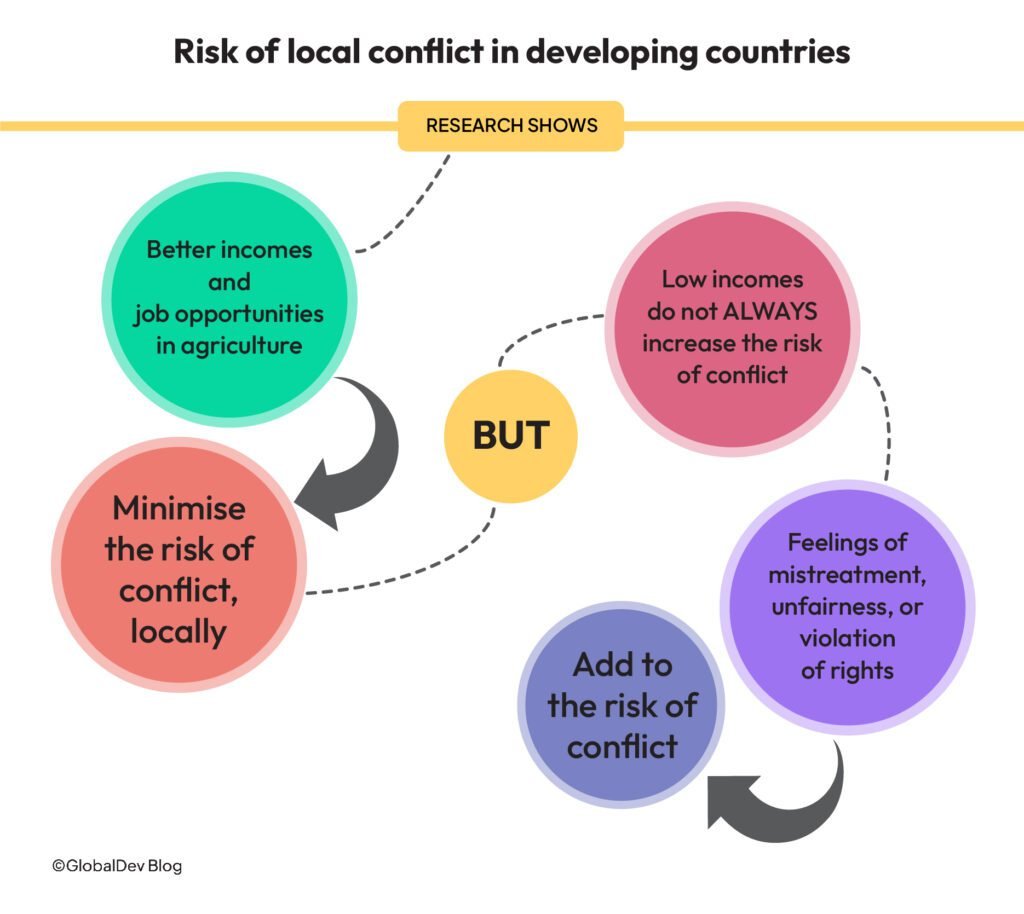Which economic factors increase the risk of conflict? Sudden changes in household income, high unemployment rates and tensions over resources all play a role. But policymakers must also exercise some caution in interpreting conflict studies, for biases in research are common.
By 2030, conflict-affected countries could be home to up to two-thirds of the world’s extremely poor. It is, of course, crucial for policymakers to understand which factors increase the risk of violence to help countries escape or avoid conflict.
Many studies show that sudden falls in income, or ‘income shocks’, can increase the risk of local conflict in developing countries.
We recently analyzed the findings of 64 studies that looked at links between income and conflicts at a local level. Looking at all these studies gave us a nuanced and comprehensive understanding of the topic that could help guide related policies. However, we also find evidence of biases in research that we believe policymakers should know of.
The sources of conflict: unpacking the systematic effects
Factors that significantly contribute to conflict risk in developing countries include those that threaten economic prospects and incomes for active (or potential) warring groups and individuals. These include sudden and hard-to-predict events, such as commodity price changes and climate fluctuations.
Research in our analysis suggests that having higher incomes and better economic opportunities in the agricultural sector can reduce the risk of conflicts in local areas. However, having lower incomes in this sector does not consistently increase the risk of conflict. This means that factors other than income, like grievances (such as feelings or perceptions of injustice, resentment, or dissatisfaction resulting from real or perceived mistreatment, unfairness, or violation of rights) and the ability of the government to maintain order, do indeed affect the risk of conflicts locally.
For example, the impact of climate events on conflicts is not solely related to changes in agricultural income. Additionally, having higher incomes and economic opportunities in the extractive sector, like oil or mineral industries, does not consistently increase the risk of conflict at the local level.
However, it’s important to consider that different studies may have different results based on the specific factors they examine or the methods they use. For example, studies that focus on negative events, like floods or droughts, or those that look at crimes such as robberies or assaults, tend to report a higher risk of conflict. On the other hand, studies that have stricter publication processes or which analyze smaller geographic areas tend to report a lower risk of conflict.
Furthermore, studies that focus on positive events related to hydrocarbons or minerals often find a lower risk of conflict, especially when they focus on a single country or include larger samples.
Biases in research
Our analysis highlights problems with biases in research, which can distort our understanding of the local effects of income shocks on conflicts. Many studies are valuable despite biases, but we advise policymakers to be aware that they may only be seeing part of the picture, and to be cautious of generalizing the results of conflict studies. This is especially true when considering whether to apply policies to countries outside the study area.
To explain further, conflict studies are not immune to publication bias. This is a common issue across all types of research, whereby scientific journal editors are more likely to publish studies with results that follow a certain pattern. They may reject other, perfectly good, studies because the results are not ‘spectacular’ enough or do not follow a certain narrative, for example.
In our case, we find that studies which report significant links between income shocks on conflicts are more likely to be published than those that find no connection. Research focusing on links between conflict and income shocks in the agricultural sector is particularly susceptible to this type of bias, especially studies that look at income shocks caused by environmental problems.
Furthermore, researchers themselves are biased. Researchers who look at agricultural problems and conflict-inducing mechanisms are susceptible to a form of confirmation bias that drives them to find stronger associations between income shocks and conflict risks. As a consequence, they are less likely to produce studies with counterintuitive results (i.e. studies that show a reduction in conflict risk following an income shock). Rather, they are more likely to produce studies that show an increased risk of conflict.
Lastly, our analysis highlights what looks like a ‘negativity bias’ in academia’s approach to income and conflicts. Indeed, nearly 70% of studies focus on the detrimental effect of income shocks on conflict – many more than look at positive effects. Compounding this distortion, journals favor studies that show a higher risk of conflict following a fall in income.
Ultimately, our analysis calls for more research into the mechanisms that link income shocks to local risk of conflict. A better understanding of these will lead to more effective peacemaking policies.








